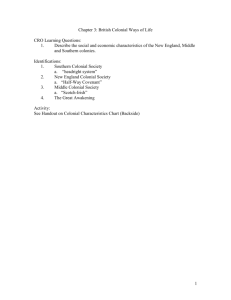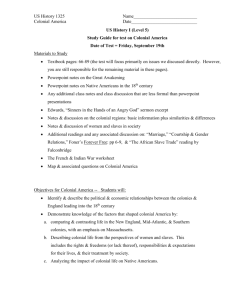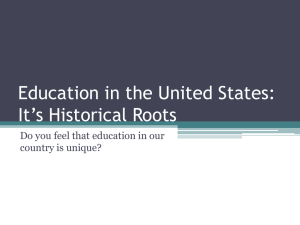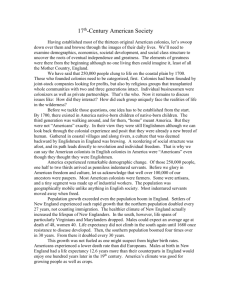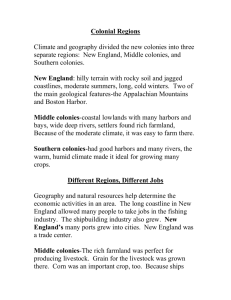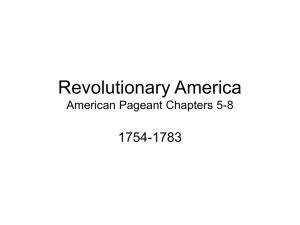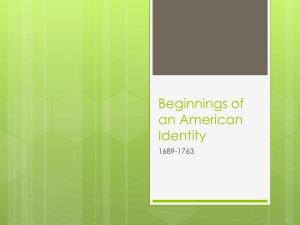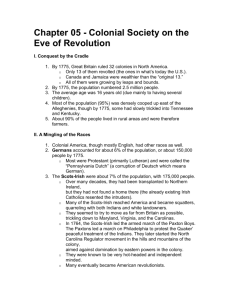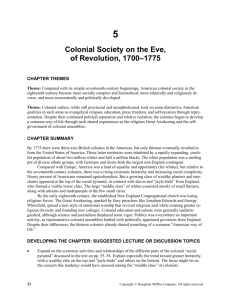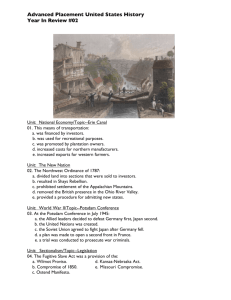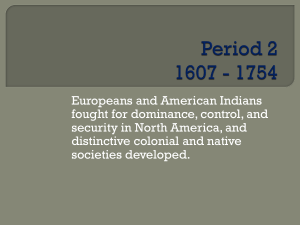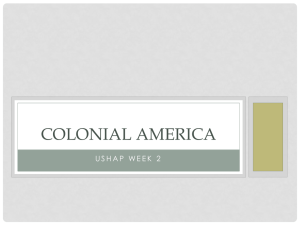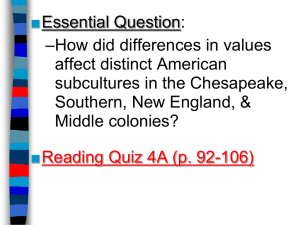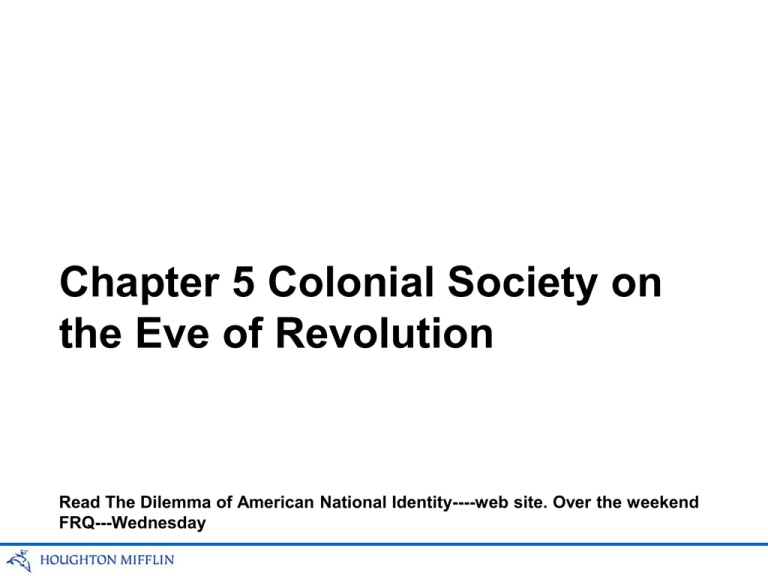
Chapter 5 Colonial Society on
the Eve of Revolution
Read The Dilemma of American National Identity----web site. Over the weekend
FRQ---Wednesday
Focus Q’s
• What is an American Identity?
• How did population growth in the eventually rebellious
colonies compare with England’s?
• What ethnicities contributed to the tapestry of peoples in the
Colonies?
• How did the social hierarchy compare with in the 17th Century
and 18th Century? And the Old World?
• What were leading and developing industries and markets in
America?
• How did the Great Awaking influence religion in America?
• How were the colonial governments similar and differences,
and how influential was England colonial governance?
Colonial Society
• By 1775 the Colonies had a population of about 2.5 million people
• All colonies were growing rapidly….natural increase average age
16.
• 95% of the Population was cooped up east of the
Alleghenies…drift.
• 90% were farmers.
• Religion will witness a REVIVAL and be challenged by Enlightment
thinking.
• America was multicolored/ multicultural----tough to classify!
• Compared with Europe, America was a land of equality and
opportunity relative to the 17 century---growing class of wealthy
planters and merchants
Immigrant Groups in 1775
America was already a
nation of diverse
nationalities in the colonial
period. This map shows
the great variety of
immigrant groups,
especially in Pennsylvania
and New York. It also
illustrates the tendency of
later arrivals, particularly
the Scots-Irish, to push
into the backcountry.
Copyright (c) Houghton Mifflin Company. All Rights Reserved.
How did 18th Century colonial society become more
complex and hierarchical than in the 17th century?
While no titled nobility or pauper class existed, except for slavery
• Nation largely of farmers, tradesmen, artisans, and shopkeepers
• Social ladder was open
• A few had become wealthy….military suppliers
• Social Rank was demonstrated at church schools
• Richest 10% in Boston and Philadelphia owned 2/3 of the wealth
• New England countryside had fewer opportunities for advancement
• Wars created a class of widows and orphans
• In the South gaps grew between wealth of gentry and poor whites
who were often driven into farm tenancy.
• Lower classes grew with indentured servants and jail birds
(paupers and convicts)
• Some in the South questioned the wisdom of importing more slaves
given the large number here-----revolt/discontent----fear of
rebellions
• Still the key to wealth LAND.
Ethnic and Racial Composition of the American People, 1790
Based on surnames.
Source: Adapted from the American Council of Learned Societies, “Report of Committee on Linguistic and National
Stocks in the Population of the United States,” 1932. Percentages total more than 100 percent due to rounding.
A South Carolina Advertisement
for Slaves in the 1750s
Note the reference to these slaves’
origin on West Africa’s “Rice Coast,” a
reminder of South Carolina’s reliance
on African skill and labor for rice
cultivation. Note, too, that half the
slaves were said to have survived
smallpox and thus acquired immunity
from further infection--and that care had
been taken to insulate the others from a
smallpox epidemic apparently then
raging in Charleston.
Charleston Library Society
The Colonial Economy
By the eighteenth century, the various
colonial regions had distinct economic
identities. The northern colonies grew
grain and raised cattle, harvested
timber and fish, and built ships. The
Chesapeake colonies and North
Carolina were still heavily dependent on
tobacco, whereas the southernmost
colonies grew mostly rice and indigo.
Cotton, so important to the southern
economy in the nineteenth century, had
not yet emerged as a major crop.
Copyright (c) Houghton Mifflin Company. All Rights Reserved.
Colonial Trade Patterns, c. 1770
Future president John Adams noted about this time that “the commerce of the West
Indies is a part of the American system of commerce. They can neither do without us,
nor we without them. The Creator has placed us upon the globe in such a situation
that we have occasion for each other.”
Copyright (c) Houghton Mifflin Company. All Rights Reserved.
Colonial Craftsmanship
In the “Pennsylvania Dutch” country, parents gave daughters painted wooden chests
to hold their precious dowry linens at marriage. The horsemen, unicorns, and flower
patterns on this dower chest confirm its origins in Berks County, Pennsylvania.
The Granger Collection
“The Magnetic Dispensary,” c. 1790
This British painting made sport of the era’s faddish preoccupations with electricity.
Following Franklin’s experiments, static electricity, generated here by the machine on
the right, was employed for “medicinal” purposes as well as for tingling
entertainments.
Library Company of Philadelphia




